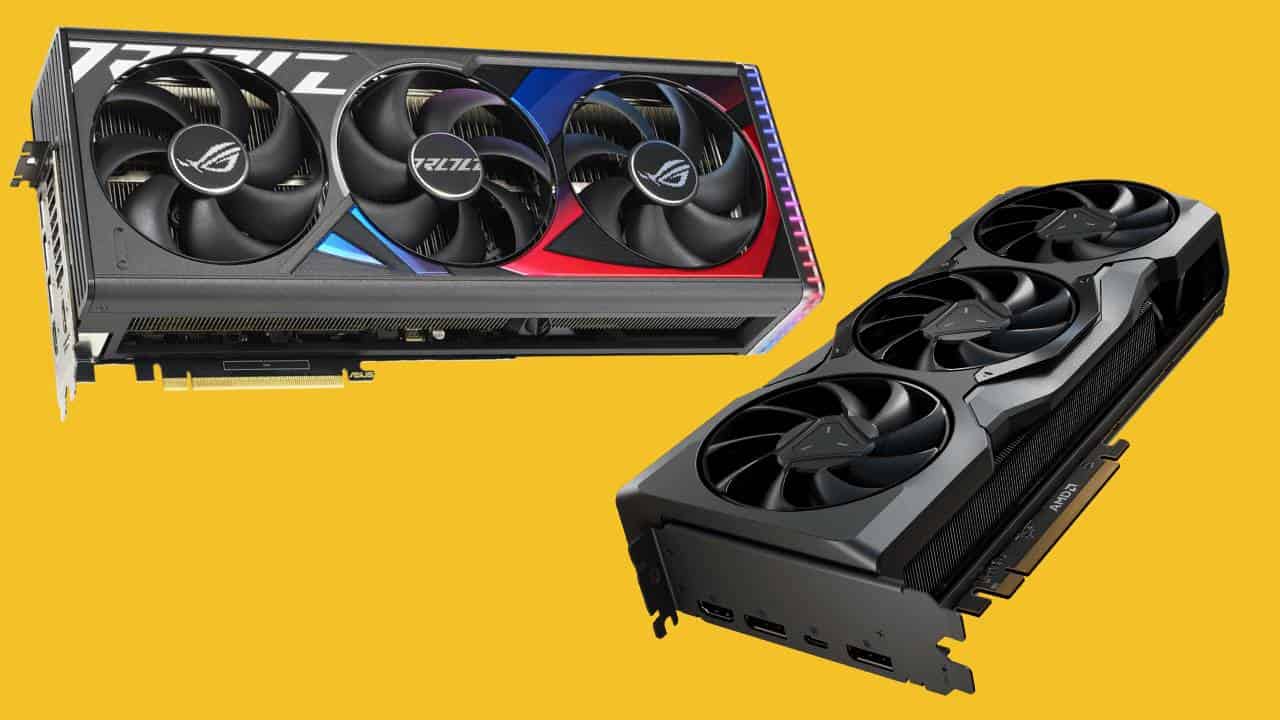Video Gamer is reader-supported. When you buy through links on our site, we may earn an affiliate commission. Prices subject to change. Learn more
If you’re looking for the best graphics card in 2024 then you’re in the right place. It’s a new year, and with it comes a brand new generation of GPUs to take advantage of. Below, you’ll find our top picks for Nvidia and AMD video cards based on their price and performance.
Building out your new PC or just looking for an upgrade, then this one vital component is key. As one of the primary driving forces in your system, we see what the best GPU is. Whether you’re looking for the best GPU for 4K gaming or something else, it’s going to require a bit of research.
As there is so much choice out there, it might be a bit daunting. As the industry has been around for quite some time now. And with a constantly changing and updating market, it needs some knowledge and effort to get your head around. So we’ve made it a bit simpler by bringing newer and useful tech that you should have an eye on. Speaking of keeping an eye out, take a look at Nvidia’s new RTX 4070 Super graphics card that can handle max settings at 1440p. Make sure you know where to buy the RTX 4070 Super so that you can weigh up you options to ensure you have the appropriate GPU.
Listing these out, we’ll also give you some the details of what to look for and what makes a good choice of graphics card. But also a lot of it will depend on your own needs and use cases. With that let’s have a look at the top range.
Best graphics cards in 2024 at a glance
These are our top recommendations for the best graphics cards available. You’ve got the RX 7900 XTX for leading gaming performance given its MSRP, the RTX 4070 Super for a value pick, and the almighty RTX 4090 as a catch-all premium option.
1. AMD Radeon RX 7900 XTX – Best graphics card for gaming
XFX Speedster MERC310 AMD Radeon RX 7900 XTX
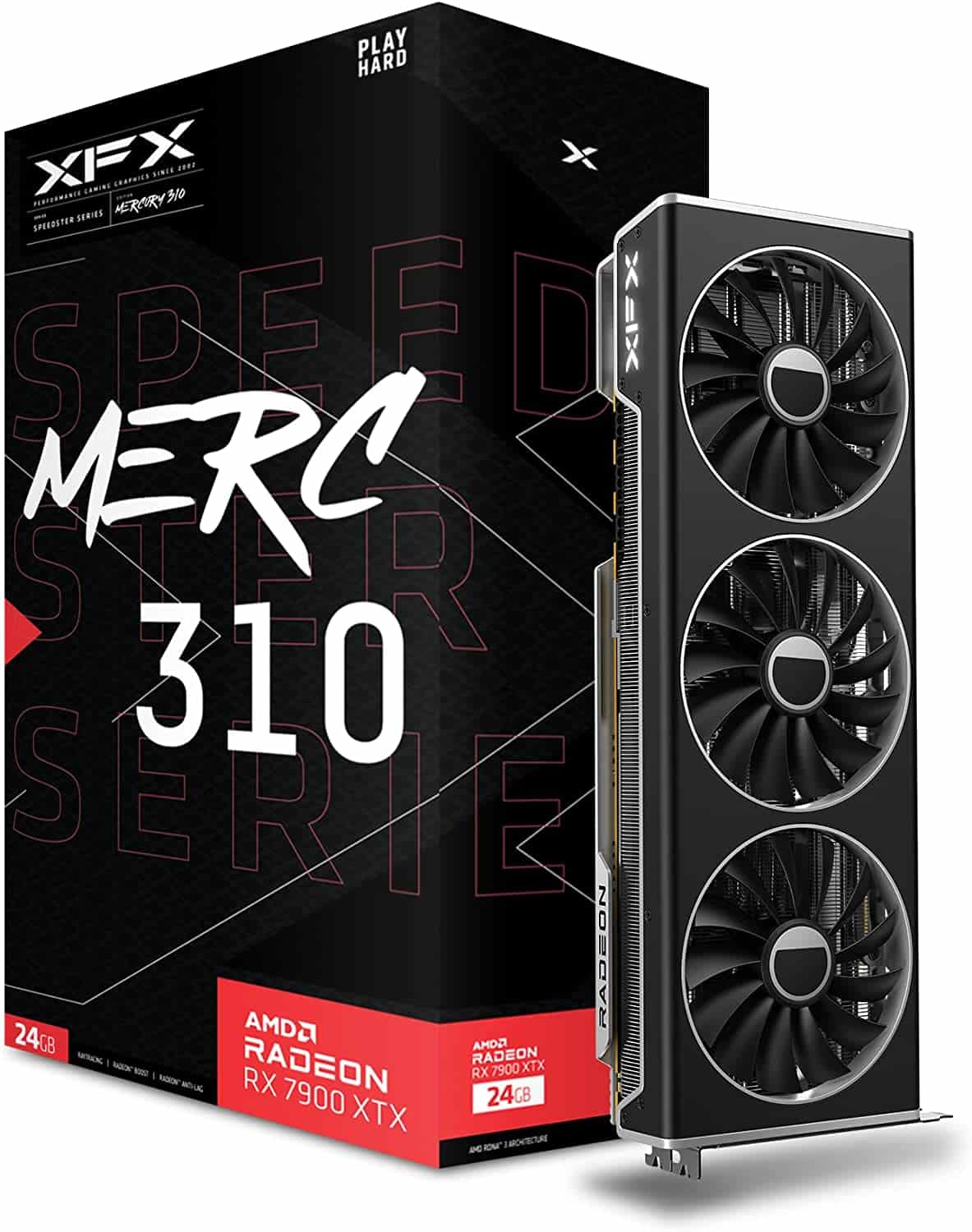
Base Clock (MHz)
1,855MHz
Boost Clock (MHz)
2,615MHz
VRAM
24GB GDDR6
Dimensions
344 x 128 x 57mm
Recommended PSU
850W
- Tons of VRAM
- Powerful performance
- Seriously fast
- Expensive
Now when it comes to the top contender for the best graphics card for gaming, in particular, there are a lot of contenders and factors to consider. But in our opinion, the AMD Radeon RX 7900 XTX is the best choice of GPU for the spot.
The RDNA 3 card combines a good performance and price point to offer a good deal. It is one of the two cards that were released for the lineup, and as the flagship card, offers a better deal than its counterpart. With a strong performance across the board, including the highly trying 4k resolution. But as the top choice, you’d expect no less from it.
For its specifications, the card features the Navi 31 XTX variant on it, with TSMCs 5nm process it has 57.7 billion transistors on the 529mm² die size. It has 96 compute units, leading to 6,144 stream processors. With 192 ROPs, 384 texture units, 6 shader engines, and 96 ray accelerators. In terms of memory, it has 24GB of GDDR6 that is across a 384-bit bus, clocked at 20Gbps for a 960GB/s bandwidth. And the card itself is clocked at 1,855MHz base, with a boost up to 2,615MHz, and a game clock of 2,455MHz. All in a package of 355W.
Although it has a high power rating, it’s not the biggest around. And for that, you get a lot of performance, although the heat output might be a consideration for when you’re in a warm enclosed room already. It does also take three 8-pin power connectors but doesn’t need any adapter or anything and is a simple plug-and-play for your power supply.
If you’re interested in seeing how it compares to a slightly more affordable RDNA 3 graphics card, why not check out RX 7900 XTX vs 7900 XT.
2. RTX 4070 Super – Best value graphics card
ASUS Dual GeForce RTX 4070 Super OC Edition
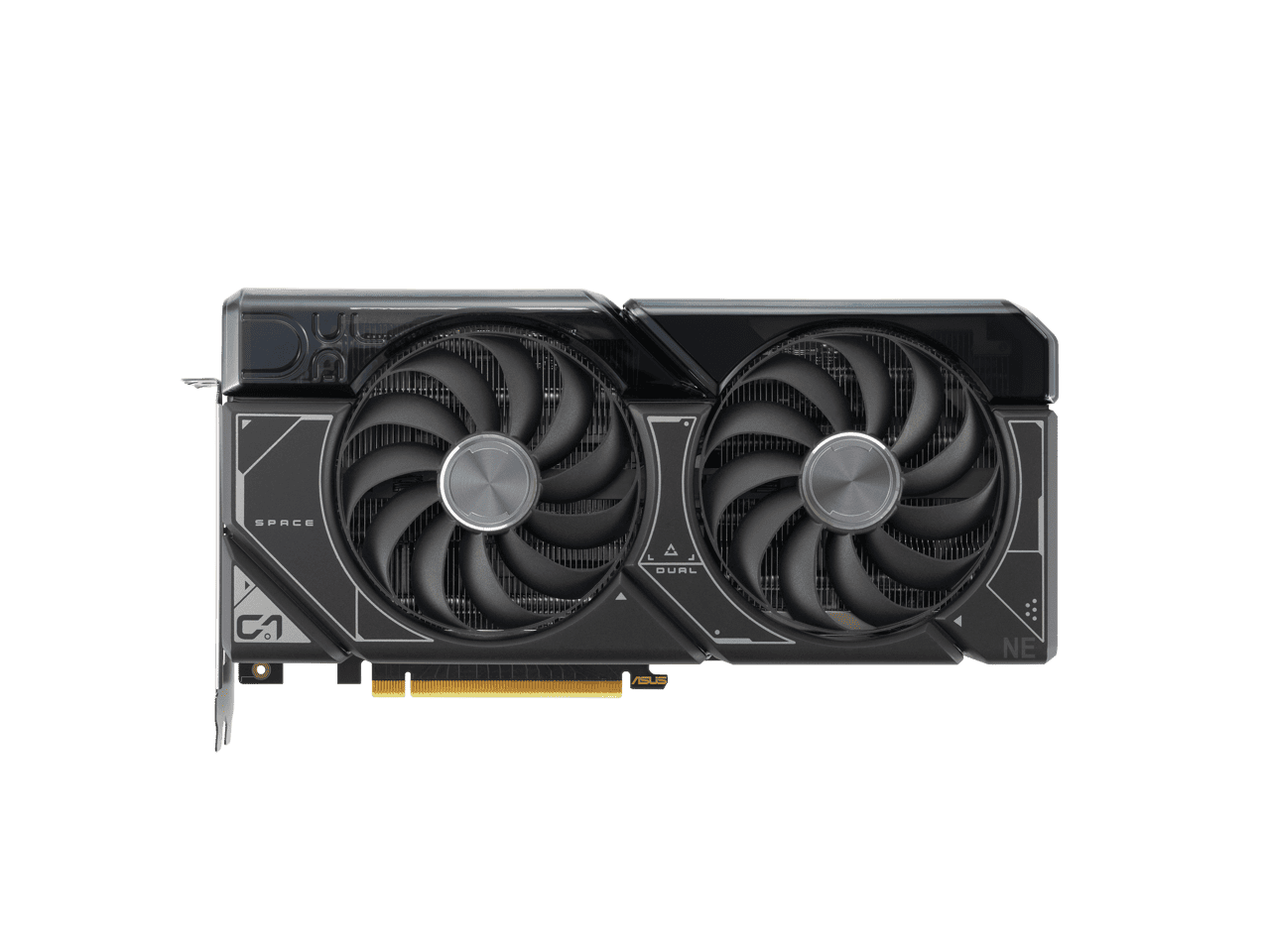
VRAM
12GB
Base Clock
2,520 MHz
Boost Clock
2,550 MHz
TDP
220W
- More CUDA cores
- Same price as original RTX 4070
- DLSS 3 Frame Generation
- Still quite expensive
Now when it comes to the other side of the market, the Nvidia GeForce RTX 4070 is the best choice of GPU from the lineup. It is the best value GPU from the Ada range as it doesn’t seem to have massive price increases over the rest. And so is the best way to enter the newest generation with the best features attached to it.
It comes with the AD104-250 processor on it. Made with TSMC’s 5nm process, it fits in it 35.8 billion transistors on the 295mm² die. This means it features 5,888 CUDA cores, 184 TMUs, 64 ROPs, 46 SMs, 184 Tensors, and 46 RT cores. Supported by 12GB of GDDR6X memory, across a 192-bit bus clocked at 21Gbps, it has a bandwidth of 504.2GB/s. And the card is clocked at 1,920MHz with a boost up to 2,520MHz on the custom card. And that whole package comes with a 200W TBP.
It is a higher power rating but not too uncommon these days, but it might just be needed. Especially as the card is even rated to work at 4k. Where it differs from the rest of the RTX 40 series lineup is also in the power connector, as it doesn’t utilise the new 16-pin (12VHPWR) connector. So no need for the special adapter or connector for the inconvenience.
3. RTX 3080 – Best previous-generation GPU
EVGA RTX 3080 FTW3 Ultra
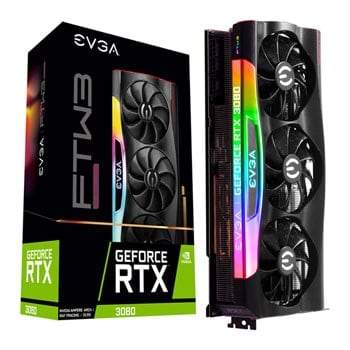
Base clock
1440MHz
Boost clock
1800MHz
VRAM
10GB
Dimensions
11.8 x 5.38, 2.75 inches
Recommended PSU
750W
- Best value option of its time
- Great performance across the board that still holds up
- Might be harder to find and at worse off pricing
Now when looking back to the previous generation, there is no better contender than the Nvidia GeForce RTX 3080. It offers the best choice for the old gen, with a good balance to performance, that ranges into a higher level like 4K. It’s one of the best GPU’s for the Ryzen 5 5600x. It was a popular choice at its time, always out of stock with a lot of scalping involved. This also makes it harder to find the best price these days, as the successors are released.
For its specifications, the card is the GA102-200 processor in the Ampere family. Made with Samsung’s 8nm process, it features 28.3 billion transistors on the 628mm² die. Coming in with 8,704 CUDA cores, 272 TMUs, 96 ROPs, 68 SMs, 272 Tensors, and 68 RT cores. Where you might find variance is in memory, initially there is the 10GB card but was improved with 12GB later on. But utilises GDDR6X across a 320-bit/384-bit bus, clocked at 19Gbps, and with a bandwidth of 760.3GB/s or 912.3GB/s respectively. The base clock is also altered from 1,440MHz to 1,260MHz but the FE boost clock remains at 1,710MHz. You also have the change in TBP with an increase from 320W to 350W. A small but large increase overall.
Either of these cards is a great choice, although the newer option comes with a price increase. So it comes down to your preference really or what you can find. You also don’t have to worry about power connectors on the older cards except maybe with Founder’s Edition cards. But the heat output is another consideration, as there is a lot of power in there to keep cool and that heat has to go somewhere. But that generation is the last where you can get an EVGA card, so if you’re a fan of their GPUs, you won’t see much more from the upcoming gens.
4. RTX 3050 – Best cheap graphics card
ZOTAC Gaming GeForce RTX 3050 Twin Edge OC
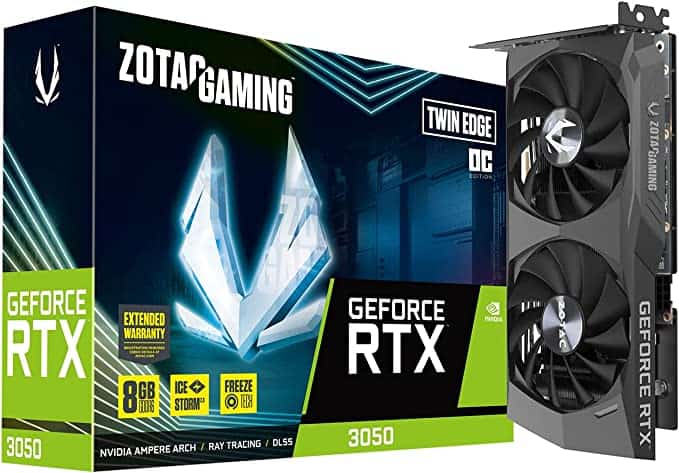
Base Clock
1552 MHz
Boost Clock
1807 MHz
VRAM
8GB
Dimensions
224 x 116 x 39 mm
Recommended PSU
300W
- Ray tracing in 1080p
- Can utilize DLSS
- Achieves 60fps in modern games
- 1080p is the limit
- No DLSS 3 Frame Generation
When it comes to the best cheap graphics card, the best budget choice, then you also have to look back to the old selection of Nvidia cards. With the RTX 3050 the best of the selection of the Ampere family. As the lowest-priced GPU in that range, it’s the best way to get entry into the family, which benefits from a range of features it has.
In it, you will find the GA106-150 processor. From Samsungs 8nm process, it has 12 billion transistors in a 276mm² die size. It features 2,560 CUDA cores, 80 TMUs, 32 ROPs, 20 SMs, 80 Tensors, and 20 RT cores. With 8GB of GDDR6 memory, with a 128-bit bus clocked at 14Gbps, it has a bandwidth of 224 GB/s. The card is clocked at 1,552MHz with a boost up to 1,807MHz. The package comes with a 130W TDP. So it’s a small and cooler card but you do lack some higher resolution performance.
The card also does have strong 1080p performance and is in the RTX 30 series family. Which means access to both ray tracing and DLSS. They can certainly improve the performance and the look of the gameplay and might be a deciding factor for you.
5. RTX 4090 – Best high-end graphics card
ASUS ROG Strix RTX 4090 OC
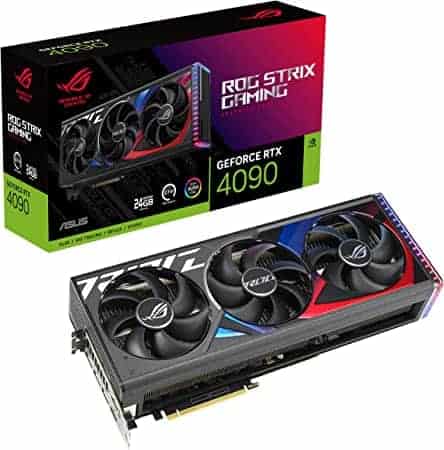
Base Clock
2235 MHz
Boost Clock
2640 MHZ
VRAM
24GB GDDR6X
Dimensions
357.6 x 149.3 x 70.1mm
Recommended PSU
1000W
- Amazing for ray tracing
- Unparalleled gaming performance
- A powerhouse in all resolutions
- Seriously expensive
- Power hungry
Now if you’re here just for the absolute best-performing card and one that’s overkill for most gamers, the Nvidia GeForce RTX 4090 is the card you’re after. The flagship of the Ada series, it shows off the full potential of it, and there’s nothing that comes close to it. And the price shows that, towering above anything close, in the same family or the competition.
It comes with the AD102-300 processor, built with TSMC’s 5nm process to get 76.3 billion transistors on the 608mm² die. On that, you’ll find the 16,384 CUDA cores, 512 TMUs, 128 SMs, 512 Tensors, and 128 RT cores. With the addition of 24GB of GDDR6X, clocked at 21Gbps across the 384-bit bus it gets a bandwidth of 1,008GB/s. Clocked at 2,235MHz and boosts up to 2,520MHz, the custom card can reach up to 2,640MHz itself. Which means all that power adds up to a TDP of 450W.
With such a high performance, the power draw and temperature are sky-high. As such we saw with the release of the card, quite the large cooling solutions, reaching up to four slots big, it is rather ridiculous. Especially the weight and the power supply you need to power it. With a recommended 1000W for the system, it can become quite the space heater for your room.
Best GPU buying advice
When it comes to picking out the differences in graphics cards there are different factors that will affect which option you’re going for. So here are just a few that might matter to you.
Resolution
One of the bigger factors affecting your graphics card will be the resolution and number of monitors you’re running. As your resolution increases, the number of pixels on it increases. This means the graphics card has to compute and process a larger number which takes more power and time. As such you’re going to need a higher-rated card to be able to run a higher screen.
One specification that is a big deciding factor for that is the VRAM in the card. the video memory is the buffer used for graphics before it comes on the screen. As such it needs to be bigger to fit the larger resolution pixels in it. As well as be able to process them quickly with fast bandwidth. This is a more expensive feature and so is found on the more expensive cards.
Performance
What it really comes down to is how well the GPU will perform. Looking at reviews and benchmarks is the best choice. But make sure it matches the rest of your setup as best as possible. So make sure there is no CPU bottleneck, or it’s plenty powerful for your resolution. This way you can make sure it’s plenty for your setup and you won’t be disappointed with the performance.
Price
The price of graphics cards can really vary. Changing between the different tiers you can find different pricing options. The change in memory and processors on the die will vary the price. And the tiers will aim for different resolutions and tiers of performance. So making sure it fits your needs but not necessarily too over the top is key.
Extra features
With the newer generation of cards, there are additional features they might include within the family of the GPU. If it’s Nvidia, AMD, or Intel, they all have upscaling options. Only AMD has it open to anyone with FSR, but RSR is the one that is on the driver level and can work on any application. As such that might be more important to you if you’re looking at the bottom-tier card, or just want that extra boost in FPS.
Then there is the addition of ray tracing. It is limited to newer cards, either the RTX family of Nvidia GPUs or AMD RX 6000 range and higher. So if that’s a key pick for you, you have a specific set to choose from. Plus their efficiency and performance will vary with generations.
Best graphics card – Frequently Asked Questions
We’re answering any and all questions you may have around the best graphics cards.
Which graphics card is best for gaming?
The two leading flagships from Nvidia and AMD respectively are the RTX 4090 and RX 7900 XTX. These two GPUs feature 24GB VRAM and are made for native 4K gaming without compromise.
Is GTX or RTX better?
RTX is the brand given to Nvidia graphics cards that are capable of real time ray tracing and DLSS AI powered upscaling. Since 2018, with the launch of the RTX 20 series, this has been the moniker for all successive generations. GTX was therefore retired, or only relegated to low end cards such as the GTX 1630.
